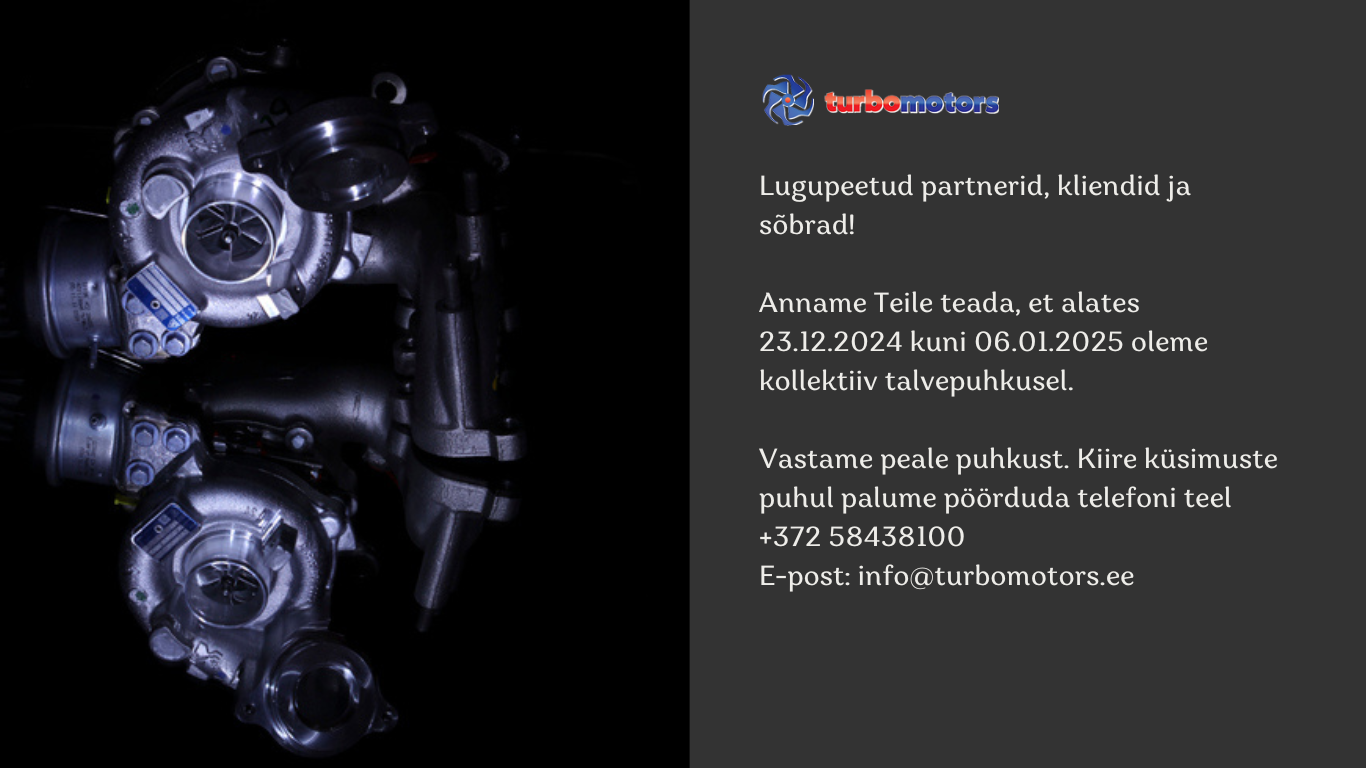Turbocharger repairing
Turbomotors restores any type of turbochargers made for car, truck, and also heavy and agrucultural machinery, that works for a long cycles in severe conditions off the roads, where top reliability is required.
Company workers have 15 years of experience in turbochargers repairs. This has a significant meaning in terms of work quality. Turbomotors also has top class equipment, uses high quality parts and comply with manufacturers requirements for repair process and overall quality.
We invest in our workshop, newest technologies and equipment. At present stage in our workshop we have computerized core-balancing machines Turbotechnics MK3 and TMI Modificata. Also we have computerized actuator testing and calibrating equipment REDAT and ATD.
REPAIR PROCESS IN DETAILS:
1. Primary inspection, full disassembling and multi-stage cleaning.
When we receive a turbocharger in need of repair, the process starts with compulsory inspection. We check if all the components comply with the type of the turbocharger, analyse the overall condition and future applicability and carefully disassemble the charger. All the details that have any unrepairable wear, damage, corrosion, contamination or cracks that is not compatible with normal work are discarded.
Each component that passes the test goes to the multi-stage cleaning line where it is first cleaned in solvent based hand or automatic washer and ultrasonic cleaning. Then the components pass the abrasive blasting cell and return to the automatic hot washer to remove any abrasive particles or residue leftovers. After that the component goes into the drier, then is inspected for any hidden damages or imperfections and is treated against corrosion.
2. Inspection, measurement and evalution.
After cleaning cycle all the components are again checked and measured against any damaged and once they have passed the inspection, they can be used in upcoming turbocharger repair process. The inspection is carried out by technical personnel and includes:
• Full visual inspection of all surfaces
• Detection of any crack or damage, hidden before the cleaning
• Measuring the components, using micrometres and digital measuring instruments
• Calibration testing and comparing with matching pattern model
• Actuator testing
3. Selection of the components to be replaced.
All the turbochargers passing the recovery cycle must receive the standard minimum kit, consisting of required new components:
• Journal bearing
• Thrust bearing
• Turbine ring
• Compressor ring
• Compressor wheel nut
• Seals
On top of that such components as turbine wheel, compressor wheel, bearing housing, variable geometry linkage and actuator can be replaced with the new ones if there is any need for that or if they did not meet required parameters during the inspection process.
In some cases repair size seals, rings and bearings could be used where necessary.
4. Turbocharger component balancing.
Turbine wheel and compressor wheel are dynamically balanced on a horizontal mechanical balancing machine. After been balanced separately, rotor and impeller are assembled and balanced as a set on a balancing machine up to 5000 RPM.
5. Center Housing Rotating Assembly (CHRA).
After primary balancing the rotor and impeller are used by a technician to assemble the bearing housing, that all together makes a turbocharger cartridge.
6. Cartrige balancing.
After assembly, the cartridge goes for a high-speed (up to 250000 RPM) balancing and oil leakage test. For relatively small car and light commercial vehicle turbochargers the British-made Turbotechnics MK3 balancing machine is used.
For heavy goods vehicles and other heavy and agricultural machinery a special balancing machine TMI Modificata is used. This machine is operated by a special program, developed for heavy trucks applications.
When final balancing is complete, technician prints out the final run data, indicating, that the turbocharger successfully passed the tests. All necessary data, such as date and time, turbocharger type and its serial number is also printed.
7. Final assembly and inspection.
After final balancing the cartridge enters the final assembly stage and is mounter inside the „snails“ (turbine and compressor housings). After installing the actuator, completely assembled turbocharger enters the final test and actuator calibration process.
Equipment used:
REDAT GateTest3 – electronic-mechanical pressure or vacuum-activated actuator tester. This piece of equipment also is capable of testing the vacuum or electronic VNT actuators.
ADT-1 – digital tester made to test the VNT electronic actuators.
8. Packaging and logistics.
After the final inspection and calibration the product is packed into plastic and completed with some necessary seals or gaskets. The package is then placed into a carton and some documentation is added. The documentation pack consists of original testing data printout, description of the previous damage and its possible causes, warranty sheet and general turbocharger installation and operation advice.
After the packaging is complete, turbocharger arrive at the storehouse, or is shipped directly to the customer by courier service such as TNT, DPD, Cargobus, Omniva or Autopasts if the customer resides outside Riga or Tallinn. Within the city our courier delivers the turbocharger directly to the customer.
Normally the turbocharger is completely repaired within 2-3 days. If necessary, we can offer remanufactured turbocharger as a replacement from our exchange stock that shortens the repair time for the customer significantly.
9. Warranty.
We offer 1 year warranty on our repairs and installed components or on the new turbocharger. There is no restriction on the mileage under the condition, that the car is properly serviced within that time.
Turbomotors is a reliable partner.

